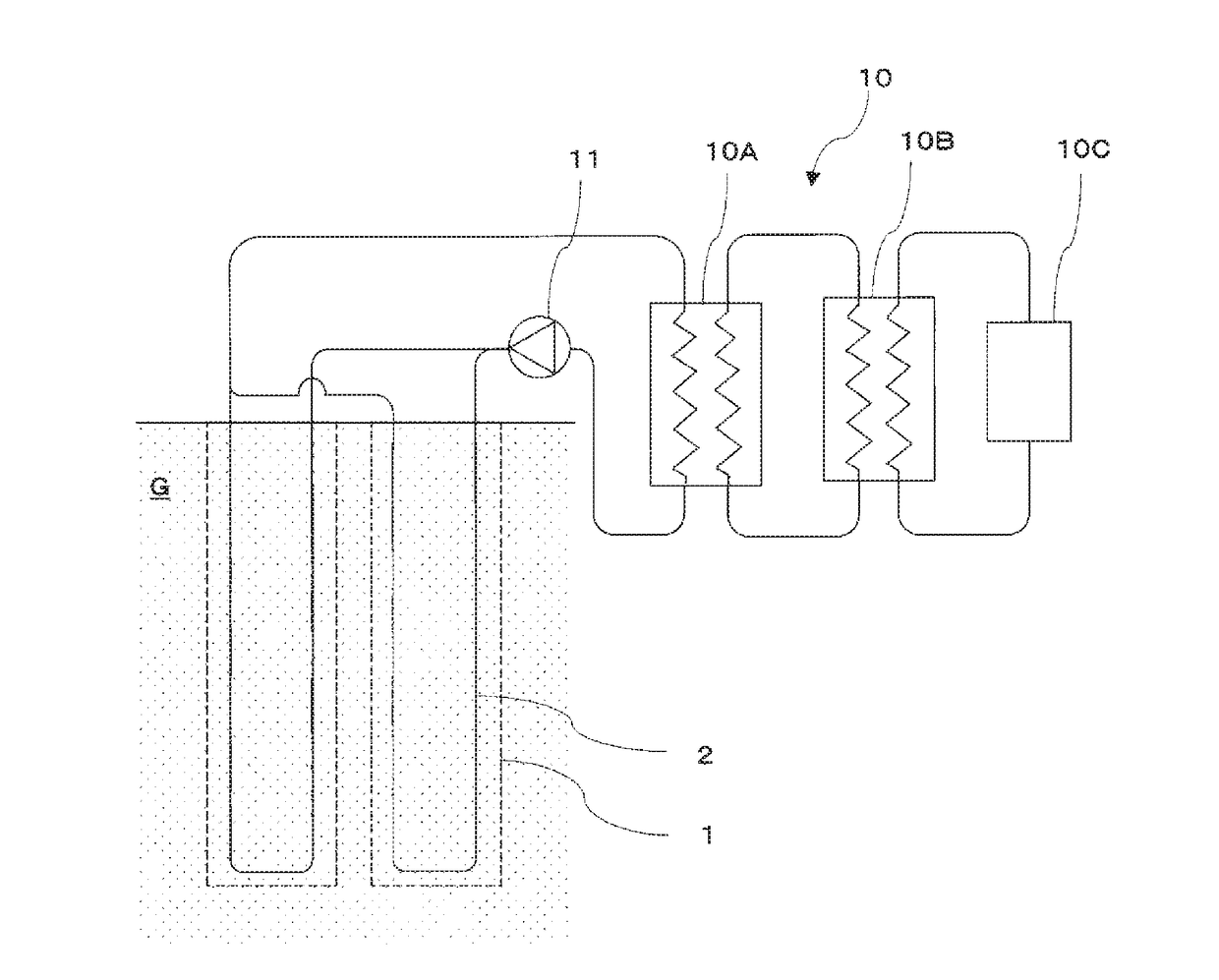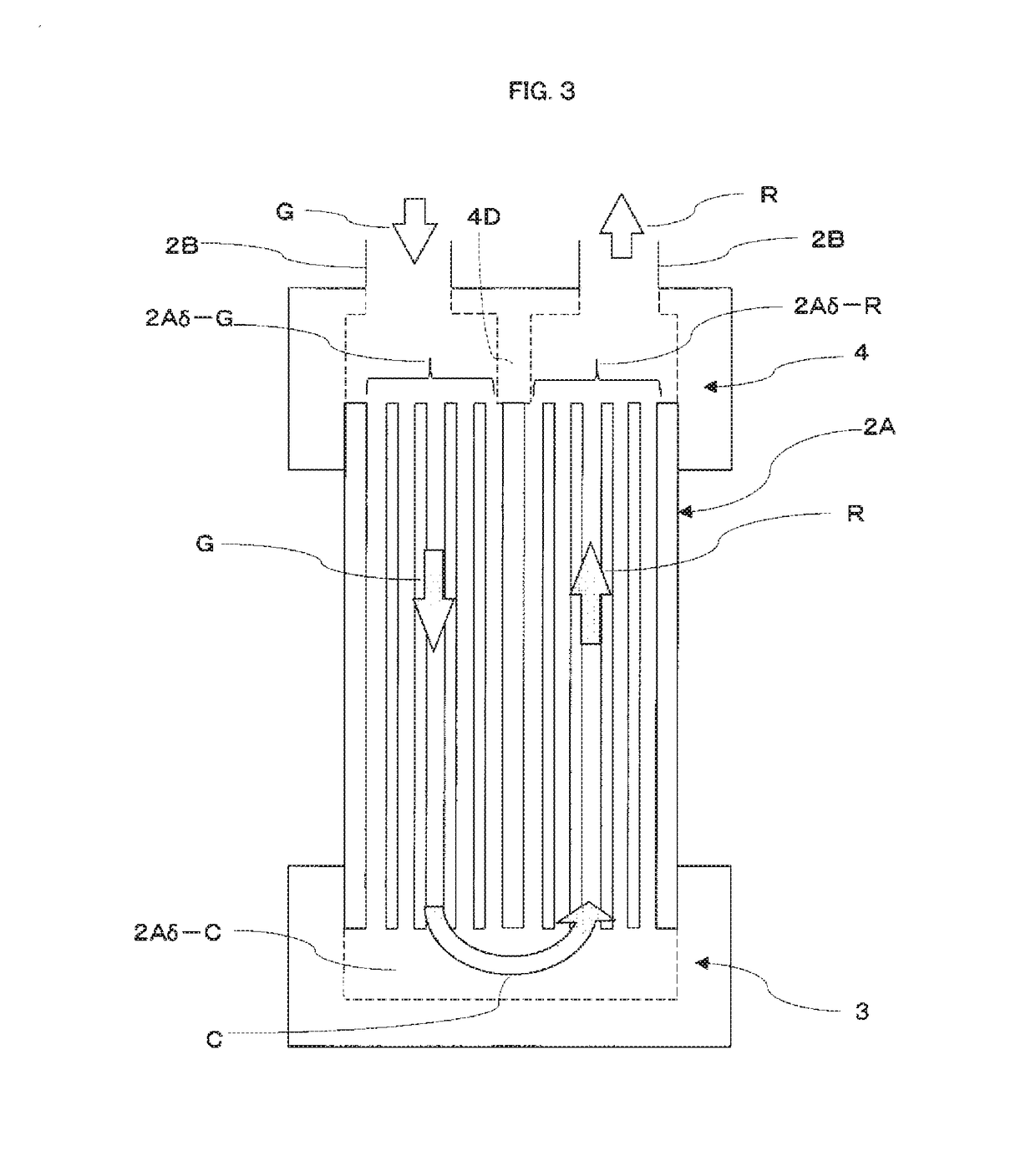Artificial ground freezing method and artificial ground freezing system
a technology of artificial ground and freezing method, which is applied in the direction of shaft sinking, shaft equipment, mining structures, etc., can solve the problems of large amount of energy, high rental cost increased operating costs of brine circulation pumps, so as to reduce the cross-section area of circulation pipes, reduce the cost of cooling and condensing coolant gas, and improve thermal efficiency
- Summary
- Abstract
- Description
- Claims
- Application Information
AI Technical Summary
Benefits of technology
Problems solved by technology
Method used
Image
Examples
first embodiment
[0101]According to the present invention, when a first coolant circulation pipe 2A is provided in a freeze pipe 1 (casing), as shown in FIG. 3, a bottom socket 3 (plugging member) is brazed on the bottom (underground end) of the first coolant circulation pipe 2A (micro channel). The connection between the first coolant circulation pipe 2A and the bottom socket 3, however, may be carried out by means of a non-brazing method.
[0102]In FIG. 3, micro-coolant passages 2Aδ-G provided on the left side in the first coolant circulation pipe 2A (5 micro-coolant passages provided on the left side out of 10 micro-coolant passages 2Aδ in FIG. 3) correspond to a coolant supply side, and micro-coolant passages 2Aδ-R provided on the right side (5 micro-coolant passages provided on the right side out of 10 micro-coolant passages 2Aδ) correspond to a coolant return side that returns to a coolant apparatus 10 (FIG. 1).
[0103]In FIG. 3, the micro-coolant passages 2Aδ-G provided on the left side and the m...
second embodiment
[0141]the present invention will be described with reference to FIGS. 6 to 9.
[0142]In the first embodiment shown in FIGS. 3 to 5, a first coolant circulation pipe 2A, composed of micro-coolant passages, is provided only near the bottom in a freeze pipe 1 (casing), and second coolant circulation pipes 2B (pipes with a circular cross-section) connected with the first coolant circulation pipe 2A through a top socket 4 (connecting member) are also inserted into the freeze pipe 1 (casing).
[0143]On the other hand, in the second embodiment, the first coolant circulation pipe 2A (micro channel) is inserted into a freeze pipe 1 (casing) throughout a vertical direction area (in vertical direction in FIG. 6) corresponding to the freeze pipe 1, while second coolant circulation pipes 2B with a circular cross-section are not inserted into the freeze pipe 1 (casing).
[0144]In FIG. 6, the first coolant circulation pipe 2A (micro channel) is provided along the freeze pipe 1 (casing) vertically.
[0145]...
third embodiment
[0172]the present invention will be described with reference to FIGS. 11 to 14.
[0173]In FIG. 11, a coolant circulation pipe (micro channel) used in the third embodiment is denoted as numeral “3C.” The coolant circulation pipe 3C is entirely formed of a hollow cylinder (pipe), and a plurality of micro-coolant passages 3Cδ-G (8 micro-coolant passages in FIG. 11) are formed in a radially outwardly located region. A radially inwardly located hollow portion 3Cδ-R constructs a coolant return path for returning a coolant to a coolant apparatus 10 (shown in FIG. 1), and also, an internal diameter of the radially inwardly located hollow portion 3Cδ-R is set so as to be larger than an internal diameter of a micro-coolant passages 3C δ-G.
[0174]The hollow portion of the coolant circulation pipe 3C may be written by phrases “a coolant return path 3Cδ-R” or “a coolant path 3C—5-R”. As mentioned above, a coolant circulation pipe 3C, in the form of hollow cylinder (pipe), may herein be denoted as “...
PUM
 Login to View More
Login to View More Abstract
Description
Claims
Application Information
 Login to View More
Login to View More - R&D
- Intellectual Property
- Life Sciences
- Materials
- Tech Scout
- Unparalleled Data Quality
- Higher Quality Content
- 60% Fewer Hallucinations
Browse by: Latest US Patents, China's latest patents, Technical Efficacy Thesaurus, Application Domain, Technology Topic, Popular Technical Reports.
© 2025 PatSnap. All rights reserved.Legal|Privacy policy|Modern Slavery Act Transparency Statement|Sitemap|About US| Contact US: help@patsnap.com



